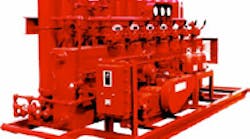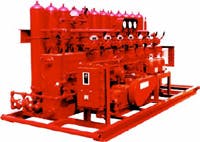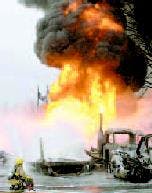Surface-mounted BOP (blowout preventer control system) hydraulic power unit features 20 accumulators, each of 11-gal size.
Without blowout preventers, fires can result that are costly not only in monetary damage, but in human lives as well.
The worldwide offshore oil business is an immense industry, employing tens of thousands of workers, engineers, and scientists — and hundreds of component suppliers. At the heart of every exploratory oil well, offshore platform, and production well is a familiar fluid power device: the accumulator.
Oil field contractors have been using bladder type accumulators for blowout prevention for more than 50 years. When drilling for oil or natural gas, pockets of high-pressure gas may be entrained in the oil, shale, or other geological formations.
In some cases, the geologic formation may contain dangerously high amounts of gas, which can cause a "kick" (essentially a bubble of explosive gas), which cannot be easily trapped or burned off. This is the major cause of oil well blowouts, also known in the movies as gushers. To prevent blowouts, gases must be safely vented or burned off.
Although romanticized by Hollywood, blowouts strike safety and economic terror into the hearts of drilling contractors. If even one spark is present, a serious fire — similar to what was seen in Kuwait during the Gulf War — is likely. Losses can exceed several millions of dollars per day!
Accumulators bop blowouts
To prevent such an occurrence, enormous valves — collectively called blowout preventers, or BOPs — are installed on all drilling well-heads. These BOP units require large volumes of high pressure fluid, delivered instantaneously under emergency conditions. To operate these valves, BOP hydraulic control power units were developed. Hydropneumatic bladder accumulators provide the fluid volume and energy required to close off the main pipe leading out of the ground or sea floor.
Wellhead pressures in the main pipe can exceed 15,000 psi, and with drill pipe diameters to 22 in., it is essential that the BOP valve close immediately. Electro-mechanical devices, which require at least a momentary startup, are much too slow. With only seconds to react, bladder accumulators — with their enormous power reserve, flow-rate, and available volume — have proven very reliable.
Accumulators to the rescue
Bladder accumulators offer many advantages for this application. A standard BOP control power unit used on land-based rigs consists of 22 or more 11-gal bladder accumulators. These are precharged to 1,000 psi, and hydraulically charged by means of an electric and air-operated pump.
This application is for true emergency standby operation — the accumulators may remain charged for months or years before being required to close the valve suddenly. Traditionally, the system operates at 3,000 psi.
High-water-content hydraulic fluid typically is used in BOP control units because of its fire resistance, low cost, ready availability, and environmental "friendliness." The most common variety is 95/5 — a mixture containing 95% water and 5% additives to enhance the otherwise poor characteristics of water.
Due to the dirty nature of the application, fluid often becomes contaminated; fortunately, bladder accumulators are extremely dirt tolerant. Most bladder failures actually result from an inadequate nitrogen gas precharge, usually stemming from improper or inadequate commissioning, operating, or maintenance procedures. Once an accumulator is properly precharged and checked, very rarely does nitrogen gas leak out. Periodic inspection and preventive maintenance ensure long life and reliable service.
Offshore means high pressures
Much higher pressures and much more severe environments are found in offshore drilling, known in the industry as subsea operations. The subsea accumulators require special materials to deal with the corrosive action of salt water and salt air, as well as extreme external pressures and temperatures.
The shell must be electroless nickel plated inside and out or internally phenolic coated with a specially formulated marine epoxy coated exterior. The oil port assembly and other wetted surfaces are predominantly 316 stainless steel. Cathodic protection may be applied to all submerged equipment, particularly in near-shore operations, where the salt content is highest. Care must be taken to inspect the accumulator for signs of corrosion whenever possible.
The units may be operated above the ocean surface or in waters of 1,500 ft to over 10,000 ft and drilling depths to 20,000 ft. At these depths, the internal fluid pressure may exceed the accumulator design pressure, due to a fluid head approaching two miles! Under this scenario, ASME and API rules allow for external sea pressure to supplement the accumulator's external design pressure. Essentially, seawater pressure acting on the outer surface of the shell tends to cancel out hydraulic pressure acting on the inner surface.
Another challenge of the offshore industry is extremely cold environments, such as found in Canada, Russia, the North Sea, and at extreme depths. Bladder compounds were traditionally limited to operation at -20° F. However elastomers are now effective at temperatures down to -50° F. Below these temperatures, the bladder loses its elasticity, and can even become brittle and crack.
In addition, nitrogen does not operate as an ideal gas at these extremely low temperatures and high pressures. Consequently, the bladder accumulator is not as efficient. Helium had been tried instead, but has not proved to be practical.
As a solution, Accumulators Inc. developed the Rigidly Connected Buoyant Float accumulator. This device has no bladder at all. Instead, it contains a syntactic foam float, which is highly resistant to attack from chemicals, extreme temperatures, and high pressure. The float attaches directly to the accumulator's poppet valve. As fluid is discharged, the float lowers to close the poppet valve, preventing the nitrogen from escaping.
This particular design has solved the problem for blowout preventer control systems in extremely cold environments. (Buoyant Float accumulators are also adaptable to extremely hot weather locales.) Of course, different precharge and operating techniques are employed when using the Buoyant Float design.
Richard T. Kendall of Accumulators, Inc., Houston, provided this discussion. Contact him at (713) 465-0202, [email protected], or visit www.accumulators.com.



